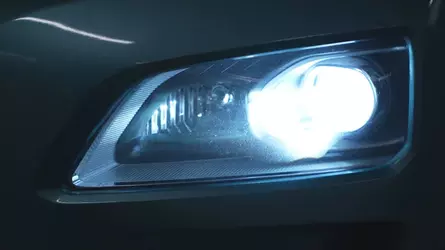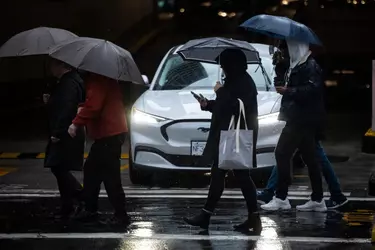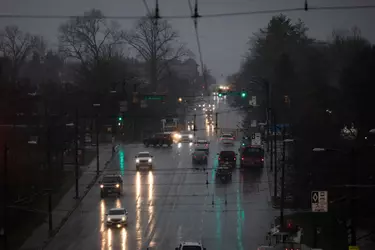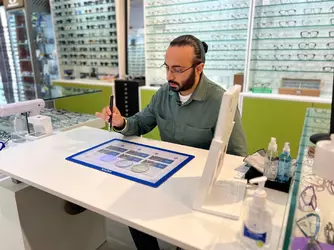
If you feel a bit like a deer caught in the headlights every time you hit a dark road recently, you're not alone. Experts say the LED headlights on newer vehicles are, in fact, more blinding than what most people grew up with.
"It's not in everybody's head. It is real," Daniel Stern, chief editor of Driving Vision News and lighting researcher, told CBC News.
"Headlights are getting brighter, smaller and bluer. All three of those things increase a particular kind of glare. It's called discomfort glare," he said.
Experts like Stern say headlight glare is a serious issue across North America as vehicles transition from warmer old-style halogen lights. Newer LED headlights create a more intense, concentrated light that's bluer and can force people to squint in discomfort.
Canada's regulations have been adjusted — but researchers say they have not yet caught up to headlight technology common in other countries.
So night drivers end up blinded — especially if their eyes are older — and looking for their own solutions that can only help so much.
LED headlights are common in newer vehicles, but pose the risk of blinding drivers if their aim is off, experts say. (Ben Nelms/CBC)

What is LED?
LED or light-emitting diode headlights use semiconductors or microchips instead of filaments found in halogen or incandescent lights. The diode converts energy into a bright white light. LED headlights last longer and are more intense. But LEDs are expensive and, if their aim is off, can blind oncoming drivers.Stern believes that's a safety issue.
"If you feel as though you can't see, that's very disorienting."
While the first LEDs were installed on cars in the '90s, Stern said the lights didn't become standard until the 2000s. They allowed a smaller light to deliver a crisp, cool glow that feels closer to natural daylight.
Now LEDs are showing up on more and more vehicles and, even when they don't come standard, many people replace regular bulbs with LEDs, despite advice not to do so.
Although the human eye can adapt to a wide range of light from sunlight to darkness, it takes some time to adjust. Especially for aging eyes, LEDs can be too bright, too blue and too concentrated.
Toronto researcher Bruce Haycock has created a simulator that mimics what it's like to drive into oncoming LED lights.
"People can't even believe that it's accurate if you haven't seen it recently, because it really is quite debilitating and it's a big distractor. [It's] very hard to see the world around those oncoming headlights because it's such a huge contrast with the really bright lights compared with the very dimly lit areas around that."
A staff scientist at the KITE research institute, Haycock was the lead engineer for the DriverLab simulator in Toronto. It's been used to study the impact of various factors on driving, including monocular vision, opioids, motion sickness and inattentional blindness — a failure to notice a hazard due to lack of focus.

Headlight glare is a growing issues for drivers as vehicles transition from warmer halogen lights to newer LED headlights that create an intense glow that disconcerts many oncoming drivers. (Ben Nelms/CBC)
Haycock's research determined that the impact of glare on driving safety — while important — is understudied, and could potentially be improved with better headlight, vehicle roadway and lighting designs.
Haycock said Germany has been ahead of the curve researching car lighting, and has for years been using automated LED arrays that can turn individual lights on or off to control glare.
"They could light up, direct the roadway ahead without throwing light into the eyes of oncoming drivers."
Canadian headlight regulations
Most of the world outside of North America has more stringent regulations to control glare from low beams and fog lamps, according to experts.In fact, Canadian headlight regulations do not even mention the word glare — or dazzle — or any synonym. Transport Canada regulates safety under the Motor Vehicle Safety Act and headlight manufacturers must comply with a set of standards around lighting systems and retroreflective devices.
Transport Canada told the CBC that its rules were updated in March 2018 to allow new lighting technologies to increase visibility without affecting other drivers, and to add requirements around headlight height and automated levelling devices that adjust the lights to avoid driver's eyes.
But Stern said Canada continues to play catchup when it comes to headlight glare issues.

Daniel Stern, chief editor of Driving Vision News, says people who think headlights are brighter are not imagining things. (Dillon Hodgin/CBC News)
He said Adaptive Driving Beam (ADB) or glare-free high beams — a system that automatically dims a person's headlights when other vehicles are nearby — is common in Europe and other parts of the world, and has been for 15 years or so. That's not so in the U.S. or Canada.
Canada only just began to permit such technologies in 2018, but few vehicle models use expensive auto-levelling systems here yet.
So there are a lot of vehicles with bright LED headlights and no protections for the eyes of other drivers.
To make matters worse, consumers who want their headlights to shine like newer models often swap out halogens for LEDs.
That can change the beam pattern, casting more glare, according to Stern.
Federal regulations specify the safety of a vehicle, as delivered by the original manufacturer, but don't apply to alterations. So when people add fog lamps or swap out halogen bulbs for LEDs, that falls on provincial and territorial governments to deal with.
Stern said cars are not routinely inspected, so a lot slips by.
Drivers, especially older ones, are left looking for eye protection. By 60, most people need three times the light to see, compared to a 20-year-old, and are more sensitive to glare, according to the National Institute of Health.
Sunglasses are not a safe options for night driving.
Jaspreet Paul Singh of Prestige Optical in Vancouver, said some anti-reflective glasses can protect a person's eyes by shining a beam of light through the lenses and cutting off certain wavelengths of light.
"They do work," said Singh, "but there is only so much that the lenses can do."

Jaspreet Paul Singh of Prestige Optical and Optometry in Vancouver, says many of his customers complain about the impact of bright headlights on their eyes. (Yvette Brend/CBC News )
The eye's pupil dilates wider at night as the eye tries to gather as much light as possible, making a sudden stab of LED light all the more painful.
Singh said a lot of customers complain about it.
"If there were a regulation on how bright a light can be, I think that would definitely be helpful. I think some of the aftermarket lights can be even more dangerous because they are not properly calibrated. The ones that come directly from the manufacturer, I think they are thinking about it, but the aftermarket ones are really bright."
Until Canada rolls out more regulations, drivers are left squinting or shelling out for anti-glare lenses, to try to cut down on excess of brightness on the road.
Until Canada rolls out more regulations, drivers are left squinting or shelling out for anti-glare lenses, to try to cut down on excess of brightness on the road.